Standing poses and core strength
In this section, you’ll learn five twisting poses. Many muscle groups are involved in twists, contracting and shortening or stretching and lengthening, the most important probably being the abdominal obliques. They support the lower back, pelvis, and internal organs; they also give strong leverage in rotating and lengthening the torso. The obliques have a big part to play in yoga poses, and sometimes that role can be extremely demanding; the poses you’ll learn here will help strengthen your obliques and other core muscles to give you needed support and balance on your mat.
Once you understand the five twisting poses, then you can practice them on their own and by using our 16-minute video that weaves the poses together into one powerful sequence.
Overview
In this section, you’ll learn five standing poses that use core strength to help you stay both grounded and lifted. Almost all standing and balancing poses require the strength of the transversus abdominis and active adductors to create stability down through the legs, up through the spine, and out through the arms. But even the seemingly simplest poses like Tree Pose (Vrksasana) engage all of the core muscles as you work hard to maintain your balance.
Once you understand the five standing poses, then you can practice them on their own and by using our 12-minute video that weaves the poses together into one powerful sequence.
Standing Poses
Mountain Pose
Sanskrit name: Tadasana
Translation: tada = mountain • asana = pose
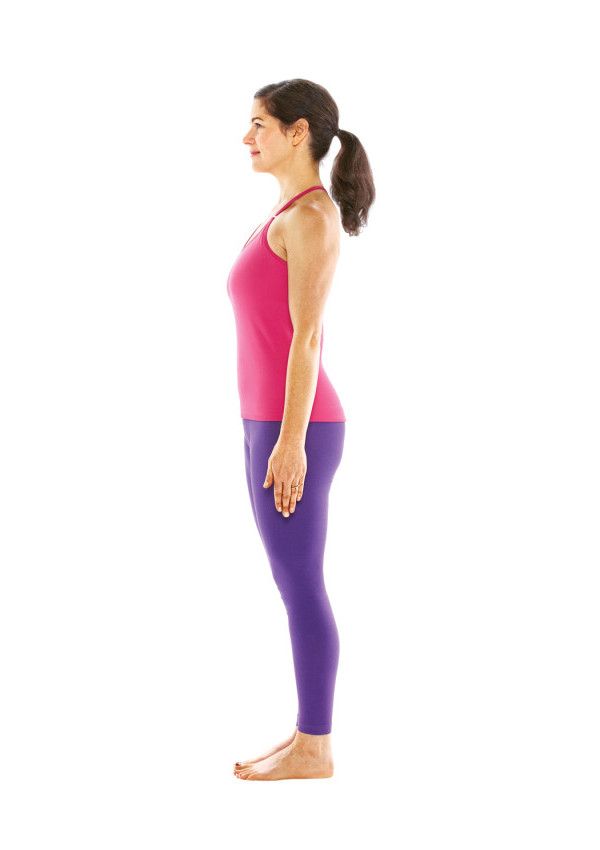
Stand with the bases of your big toes touching, heels slightly apart, so that your second toes are parallel. Look down to start and move your hips back and forth and side to side. Gradually reduce this swaying to a standstill, with your weight balanced evenly on the feet, centering your hips over your ankles. This should help you maintain a slight lumbar curve. You can also lift and spread your toes and the balls of your feet, then lay them softly down on the floor, to feel grounded.
Firm your thigh muscles and lift the knee caps, without hardening your lower belly. Squeeze the inner legs toward each other, turning on the adductor muscles. If you still can’t feel your midline, lift the inner ankles to strengthen the inner arches, then imagine a line of energy all the way up along your inner thighs to your groins, and from there through the core of your torso, neck, and head, and out through the crown of your head. Turn the upper thighs slightly inward.
Release your hands by your sides. Press your shoulder blades into your back, then widen them across and release them down your back. Without pushing your lower front ribs forward, inhale to lift the top of your sternum straight toward the ceiling. Widen your collarbones. Exhale to pull the lower belly in and lengthen your tailbone toward the floor and lift the pubis toward the navel. Take a few breaths here.
Balance the crown of your head directly over the center of your pelvis, with the underside of your chin parallel to the floor, throat soft, and the tongue wide and flat on the floor of your mouth. Soften your eyes.
Stay in the pose for 30 seconds to 1 minute, breathing easily. Then shake it out.
Tree Pose
Sanskrit name: Vrksasana
Translation: vrksa = tree • asana = pose
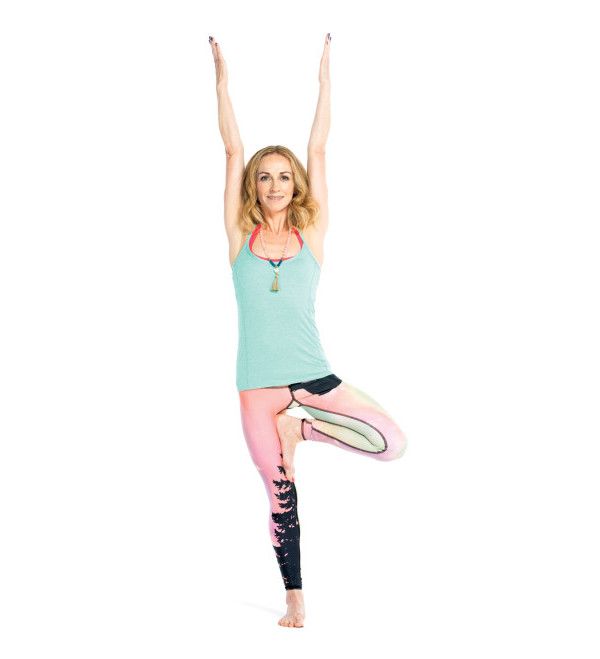
Stand in Mountain Pose (Tadasana). Shift your weight slightly onto the right foot, keeping the inner foot firm to the floor, and bend your left knee. Reach down with your left hand and clasp your left ankle.
Draw your left foot up and place the sole against the inner right thigh; if possible, press the left heel into the inner right groin, toes pointing toward the floor. The center of your pelvis should be directly over the right foot. If that is not accessible, place your left foot on your right shin. Avoid placing it on your knee.
You can rest your hands on the top rim of your pelvis for stability as you make sure the pelvis is in a neutral position, with the top rim parallel to the floor. Lengthen your tailbone toward the floor. Firmly press the left foot sole against the inner right thigh and resist with the outer right leg.
On an inhalation, raise your arms alongside your ears or press your hands together in Anjali Mudra, with your palms together at your heart. Gaze softly at a fixed point in front of you on the floor about 4 or 5 feet straight ahead. On an exhalation, draw in transversus abdominis and lift your pelvic floor, sending energy from the feet up through the crown of your head.
Stay for 30 seconds to 1 minute. Step back to Tadasana with an exhalation and repeat for the same length of time on the other leg.
Extended Hand-to-Big-Toe Pose
Sanskrit name: Utthita Hasta Padangusthasana
Translation: utthita = extended • hasta = hand • pandangustha = big toe • asana = pose
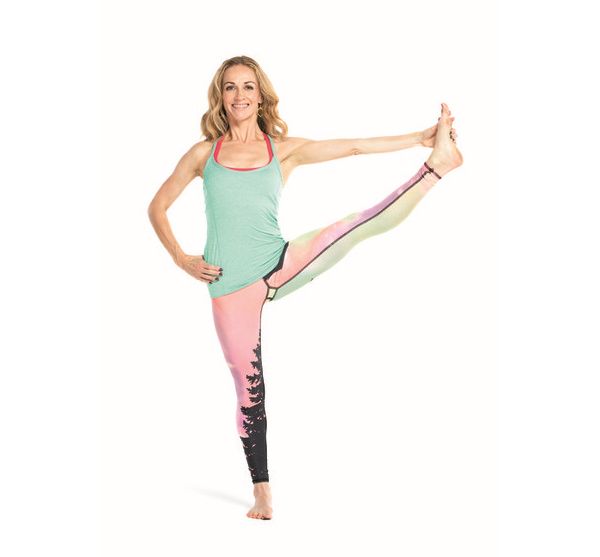
From Mountain Pose (Tadasana), bring your right hand to your hip and line up your hip bones over your ankles. Bend your left knee in toward your belly.
Either hold the left shin with your left hand or reach your left arm to the inside of the left thigh and grab your big toe with your middle and index fingers. If your hamstrings are tight, hold a strap looped around the right sole.
Firm the front thigh muscles of the standing leg, and press the outer thigh inward. Then on an exhalation, engage the transversus and rectus abdominis and oblique muscles and extend your left leg forward. Straighten the knee as much as possible. Keep the right thigh back as you inhale to lengthen the spine. Exhale to pull the low belly in. Lengthen your tailbone. If you’re steady, slowly swing the leg out to the left. Breathe steadily to help you balance.
Hold for 30 seconds, then swing the leg back to center and lower the foot to the floor with an exhale. Repeat on the other side for the same length of time.
Warrior Pose II
Sanskrit name: Virabhadrasana II
Translation: Virabhadra = the name of a fierce warrior, an incarnation of Shiva, described as having a thousand heads, a thousand eyes, and a thousand feet, wielding a thousand clubs, and wearing a tiger’s skin • asana = pose
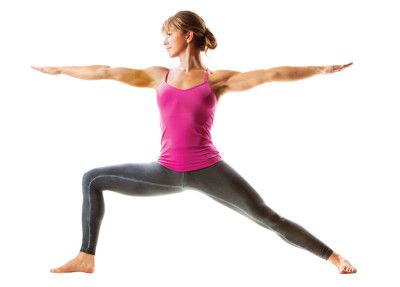
Stand in Mountain Pose (Tadasana). With an exhalation, step or lightly jump your feet 3 1/2 to 4 feet apart. Raise your arms parallel to the floor and reach them actively out to the sides, shoulder blades wide, palms down. Your ankles should be underneath your wrists.
Turn your right foot slightly to the right so your toes are facing right and your left foot out to the left a little less than 90 degrees. If you drew a line from the right heel back, it should intersect the arch of the left foot. Firm your thighs and make sure your left thigh is centered with the left kneecap, over the center of the left ankle.
Turn on the core by inhaling to squeeze the adductors or inner thighs isometrically toward one another. This encourages the pelvic floor and transversus abdominis to engage. Exhale and bend your right knee over your right ankle, so that the shin is perpendicular to the floor. If possible, bring the left thigh parallel to the floor. Keep the left gluteus maximus active to protect the hip joint. Anchor this movement of the right knee by strengthening the left leg and pressing the outer left heel firmly to the floor.
Inhale to lengthen, pulling the lower belly up and in. Exhale to lengthen the tailbone toward the floor. Scoop your outer right hip under. Keep the adductors working. Stretch the arms away from the space between the shoulder blades, parallel to the floor. Don’t lean the torso over the left thigh: Keep the sides of the torso equally long and the shoulders directly over the pelvis. Press the tailbone slightly toward the pubis. Turn the head to the left and look out over the fingers.
Stay for 30 seconds to 1 minute. Inhale to come up. Reverse the feet and repeat for the same length of time to the left.
Goddess Stance While "Cleansing With Fire"
Sanskrit name: Utkata Konasana with Agni Sara Dhuati
Translation: utkata = powerful, fierce • kona = angle • asana = pose • agni = fire • sara dhuati = to rinse, wash, cleanse, purify, make bright
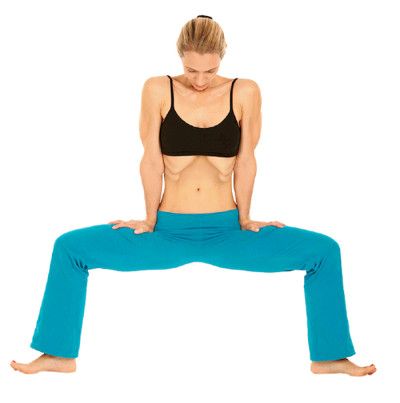
Stand with your feet about 3 feet apart and bend your knees, knees tracking over the toes, thighs parallel to the floor if possible. Press the heels of your hands into your inner thighs. Squeeze the adductors together to move the energy up and into your midline and core.
Exhale through your mouth, hold the breath out, pull the belly up and in, and bring your chin toward your chest.
Using the diaphragm and abdominal muscles (rectus and transversus abdominis and obliques), pull your belly back from the roots of your pelvis. Relax your belly but hold the breath.
Continue to pull the belly in and relax it, repeating until you must inhale. That’s one round. Beginners, do 2 to 3 rounds; intermediates, 4 to 6.
Practice
This yoga video incorporates all five standing poses, plus some transitions and counter poses, into one smooth, easy-to-follow sequence. Follow along on your own mat to practice the poses you just learned, get a better feel for and understanding of your transversus abdominis and other essential core muscles, and continue building core strength and balance. Before you start, take a few slow breaths to settle in, then warm up with 2-3 rounds of Sun Salutations.
Wrap up

In this section, you learned about standing poses and why the muscles they engage are so key for core strength and support in other balancing poses. You also learned how to do five standing poses that enable you to work and strengthen vital core muscles, especially the transversus abdominis.
Practice the standing poses individually when you have a few minutes, or by mindfully inserting them into your regular yoga practice. Or, for more sustained core work, practice the full video sequence. Either way, aim to practice every day for the next week.
